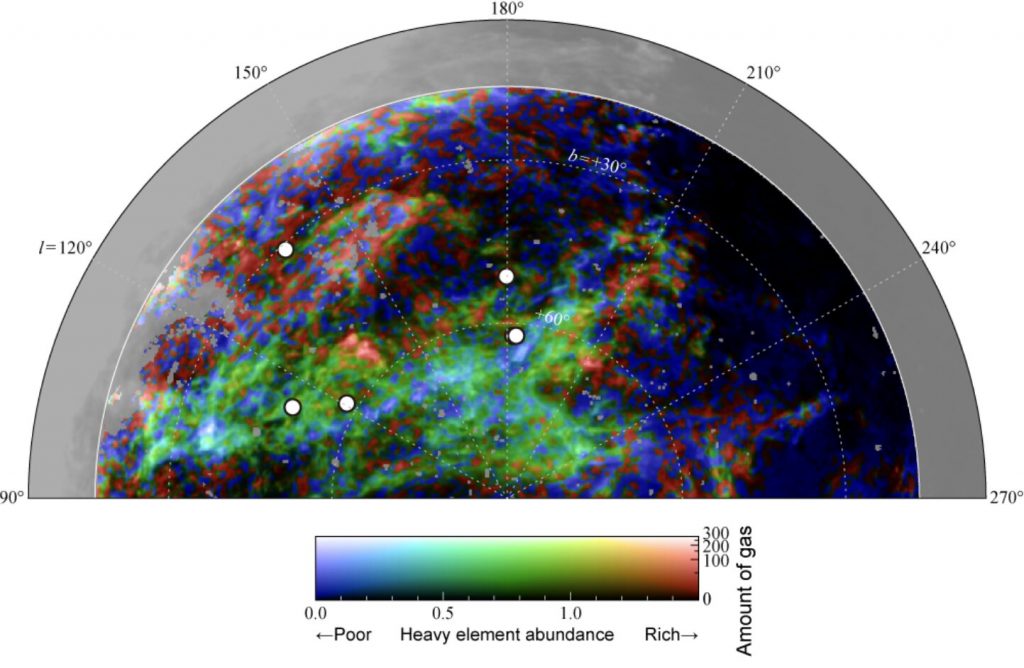The Milky Way is a huge recycling factory. Stellar winds and supernova explosions scatter material below and above the galactic plane, but like water in a fountain, these rarefied clouds succumb to the disc's gravity and then fall back into the galactic plane. Eventually, the gas and dust that make up the clouds combine to form new stars, completing the recycling process.
However, according to two Japanese astronomers, the falling clouds also contain large amounts of extragalactic material, indicating that extragalactic raw materials are also entering the recycling spring. The exact details of the process are not yet known. According to radio astronomer Jay Lockman (NRAO), the new results are interesting. They certainly add to our knowledge of the Milky Way and its environment, but they probably don't represent the full picture.

In the 1960s, radio astronomers detected clouds of neutral hydrogen thousands of light-years below and above the plane of the galaxy, approaching and moving away from us at tens of kilometers per second. We have identified two types of these clouds: high-velocity clouds (HVC) that move at over 100 kilometers per second and are usually farther away than slower clouds, called intermediate-velocity clouds (IVC), which are located closer to the galactic plane.
Takahiro Hayakawa and Yasuo Fukui of Nagoya University in Japan studied the formation of both types of clouds. To do this, data from the Effelsberg radio telescopes in Germany and the Parkes radio telescopes in Australia were compared with data recorded at sub-millimeter wavelengths by the European Space Agency's Planck spacecraft.
Radio astronomy data with a wavelength of 21 cm revealed the amount and velocity of neutral hydrogen gas in the clouds. Meanwhile, Planck spacecraft data showed that the clouds contain a large amount of small solid dust particles, an indicator of the amount of heavy or metallic elements.
The low metallicity of the high-velocity clouds suggests an extragalactic origin, which is consistent with previous studies using less precise techniques. According to the 20-year-old “galactic fountain” theory, medium-velocity clouds are formed primarily from material from stellar winds and supernova explosions. If so, it must contain a lot of heavy elements that are formed during nuclear fusion in the interior of stars.
However, the new results show that medium-velocity clouds contain less dust, which means fewer heavy elements, than expected. According to the researchers, they instead contain large amounts of pure gas outside the galaxy. About the results in the Monthly Bulletin of the British Royal Astronomical Society It has been reported.

In fact, it's possible that extragalactic gas is present in larger quantities than the new measurements show: according to Hayakawa and Fukui, relatively intact clouds could interact with the metal-rich gas in the Milky Way's halo and slow down over time. As a result of “pollution”.
Lockman emphasizes that the new study “in no way denies the existence of the Hungarian Fountain and its products.” Some medium-velocity clouds have a significant mineralogical and chemical composition (due to the presence of hydroxyl-like molecules, for example) similar to clouds in the galactic disk. “These medium-velocity clouds may be the product of a galactic fountain.”
Furthermore, it is also not impossible that some medium-velocity clouds are actually high-speed clouds in disguise. “We can only measure one component of the three-dimensional motion of a celestial body.” says Lockman. “There may be 'slow high-velocity clouds' that have small radial velocities due to the projection effect.”
Nearly sixty years after their discovery, the high- and medium-velocity hydrogen clouds surrounding the galactic disk still hold secrets. It is hoped that future facilities such as the Square Kilometer Array (SKA) radio telescope system and the Next Generation Very Large Array (ngVLA) under development will reveal details of the Milky Way's environment, sustainability and recycling capacity.
source: Sky and telescope
comment












































